 Image search results - "inabe" Image search results - "inabe" |

Minabe boasts Japan's largest plum tree groves. The trees cover the mountain slopes and a sweet aroma prevails. JR Minabe Station
|
|
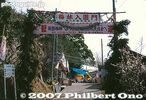
Entrance to Minabe Plum Grove. The best time is around mid-Feb. 南部梅林
|
|

Slopes covered with plum trees.
|
|
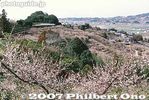
Plum blossoms
|
|
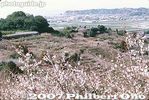
An awesome sight in Minabe, Wakayama.
|
|
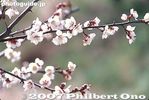
Plum blossoms
|
|
|
|
|
|
|

My video of the Ageuma Festival at Inabe Shrine in April (猪名部神社). Watch the horse successfully jump over the barrier atop the slope. Not to be confused with the larger Tado Ageuma Festival.
|
|

Inabe Shrine, where the Oyashiro Matsuri or Ageuma festival is held on the first Sat. and Sun. of April (if it falls on the 1st and 2nd, the festival is held on the 8th and 9th) in Toin, Mie Prefecture. A 15-min. walk from Toin Station on the Sangi Line.
|
|

The festival's main event is the Ageuma (Leaping or Rising Horse) ceremony held 12 times on Sat. and six times on Sun. One of the horses to be used. The Ageuma is unique to Mie and started here at Inabe Shrine.
|
|

The end of the slope where the horse is to leap over the steep earthen wall. Cherry trees accent the steep incline. The horse gallops and full speed for about 500 meters before encountering this steep incline.
|
|

On both sides are special spectator seating (decorated in red/white) for the shrine priests and VIPs. We did not see any riders or horses get injured this day. These photos were taken on April 5, 2009.
|
|

This is what the steep incline looks like from the other side. The galloping horse must manage to leap up and over the steep wall called the Agezaka (上げ坂).
|
|

The Ageuma or Leaping Horse ceremony is only one of the religious ceremonies held during the Oyashiro Festival. The god of wooden architecture is one of the gods Inabe Shrine worships. Carpenters from this area built Horyuji and Todaiji in Nara.
|
|

This earthen wall looks like 2 or 3 meters high. This festival is unique to Mie Prefecture. A similar and much more crowded Ageuma ceremony is held at Tado Shrine also in Mie and not far from Inabe Shrine.
|
|

The wall has a notch in the middle for the horse to leap up and over. Inabe Shrine's Ageuma ceremony is older than Tado Shrine's. The festival was started in 1192 by the local castle lord and shrine priest to strengthen the spirit of the youth.
|
|

In 1203, the steep embankment was built and the Ageuma and yabusame ceremonies were held. Along the short galloping course up to the steep incline, makeshift bleachers for spectators are built for the festival.
|
|

Stairs to the bleachers which are actually compartments of sitting areas. The bleachers line both sides of the course leading to the steep incline.
|
|
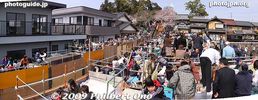
The bleacher seats are sold by auction to the highest bidder. Those next to the steep incline are the most expensive, costing 200,000 yen or higher for one compartment fitting several people. I was in a compartment costing 7,000 yen.
|
|

There are six jockeys, all local teenage boys, chosen by lottery. They have to be quite brave to undertake the Ageuma ceremony since accidents and injuries do happen. Some parents refuse to allow their sons to be chosen.
|
|

The jockeys wera a colorful costume, the hanagasa hat has a different decoration (pine tree, peony, iris, etc.) for each jockey. Each jockey represents a local district in Toin town.
|
|

Before the festival, the six riders undergo a period of purification in the morning and evening in the river. On the day of the festival, they bathe in the river. This one is getting on the horse.
|
|

And he's off, going at full speed. It takes only 10-15 sec. for him to run up to the incline.
|
|

Men await for the horse on the incline. They help to get the horse over the top and prevent injury to the rider.
|
|
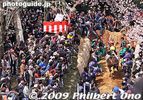
The horse approaches the steep wall.
|
|
|
|
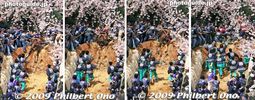
The horse gets stuck as its hind legs cannot push off from any surface. It kept kicking its hind legs as it desperately tried to get over the embankment and it finally did. This was the first run of the day on Sunday.
|
|

The horse makes it over the top. On Sat., the first day of the festival, there are 12 Ageuma runs. On Sunday, the second day, there are six Ageuma runs starting at 1 pm. In the morning, they have a few practice runs, but do not try to go over the top.
|
|

The next rider is prepared. He sits in a sacred compartment, gets his hanagasa hat adjusted, and waits for his horse to arrive. He was stern-faced. There's a 15-20 min. break between each Ageuma run.
|
|

This is near the start of the course where the rider gets on the horse.
|
|
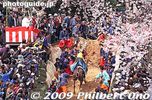
And there he goes up on the incline.
|
|

After a few hind-leg kicks, the horse manages to go over. When the horse goes over, it is an omen that this year's harvest will be abundant. Imagine the enormous pressure on the rider to go over the top.
|
|

Next horse up. In the past, they spiked the horse with stimulants to make it more excited, but they discontinued that practice.
|
|

Rider with hat bearing an iris flower prepares to mount.
|
|

There he goes.
|
|

The running course is quite short, maybe 100-150 meters. It cannot be too long or else the horse will get too tired to make the final leap.
|
|

This horse was the most successful of the day. It made a clean leap in one try.
|
|
|
|
|

The horse makes a nice leap up.
|
|
|

This is what the top of the incline looks like. A bunch of people wait for the horse to come up.
|
|

And there he is.
|
|
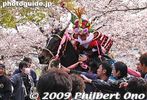
The rider looks relieved, and proud to have a lifetime memory.
|
|

The victorious rider holds out a fan and sings a victory song. People celebrate the imminent abundant harvest.
|
|

Riders make a "victory lap" within the shrine grounds.
|
|

This is definitely one of the more unique and exciting festivals I have seen in Japan. I have to give much credit to these young and brave lads.
|
|

Rider and his hat.
|
|

On SUnday, the second half of the festival is a procession from Inabe Shrine to a horse riding ground nearby at 3 pm. The yabusame horseback riding is then held at 3:30 pm.
|
|
|
|

Inabe Shrine's statue of a sacred horse near the horse riding ground.
|
|

The procession crosses the river and heads for the horse riding ground. 神霊渡御
|
|
|
|
|
|

Shrine priest
|
|
|
|
|
|

One of the riders.
|
|

The group of men sing for the rider.
|
|
|
|
|

One of the jockeys shoots an arrow toward the river.
|
|
|
|
|
|

Horse riding ground (baba). It looks like 500 meters or so.
|
|

This is one end of the riding course.
|
|

The jockeys galloped through the course several times.
|
|
|

The other end of the riding course.
|
|

One end of the riding course.
|
|
|
|

This event is called yabusame. Although they wear arrows on their backs, they do not shoot any arrows while riding. They just gallop straight along the course.
|
|

It must be fun to ride that fast.
|
|

They kept riding back and forth until twilight. Toward the end, they tossed these batons to people.
|
|

One rider waves around his baton before tossing it. This lucky little girl got one.
|
|

He waves it around before tossing it.
|
|
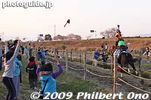
He tosses the baton.
|
|

And so all these people are waving their arms shouting, "Toss it to me!" Also see my YouTube video here.
|
|

This rider I will never forget.
|
|

Here he comes, ready to toss his baton. Now I was watching this through my camera lens and shooting continuously at 6 frames per sec.
|
|

The moment after this shot was taken, this baton hit my camera lens and bounced off. A kid nearby quickly picked up the dropped baton. That's okay, I let him have it. My gift to the local people.
|
|

My camera was fine. Nothing broken, but the edge of my lens filter had a slight dent...
|
|

Oyashiro Festival poster.
|
|
|
|
|
|
|